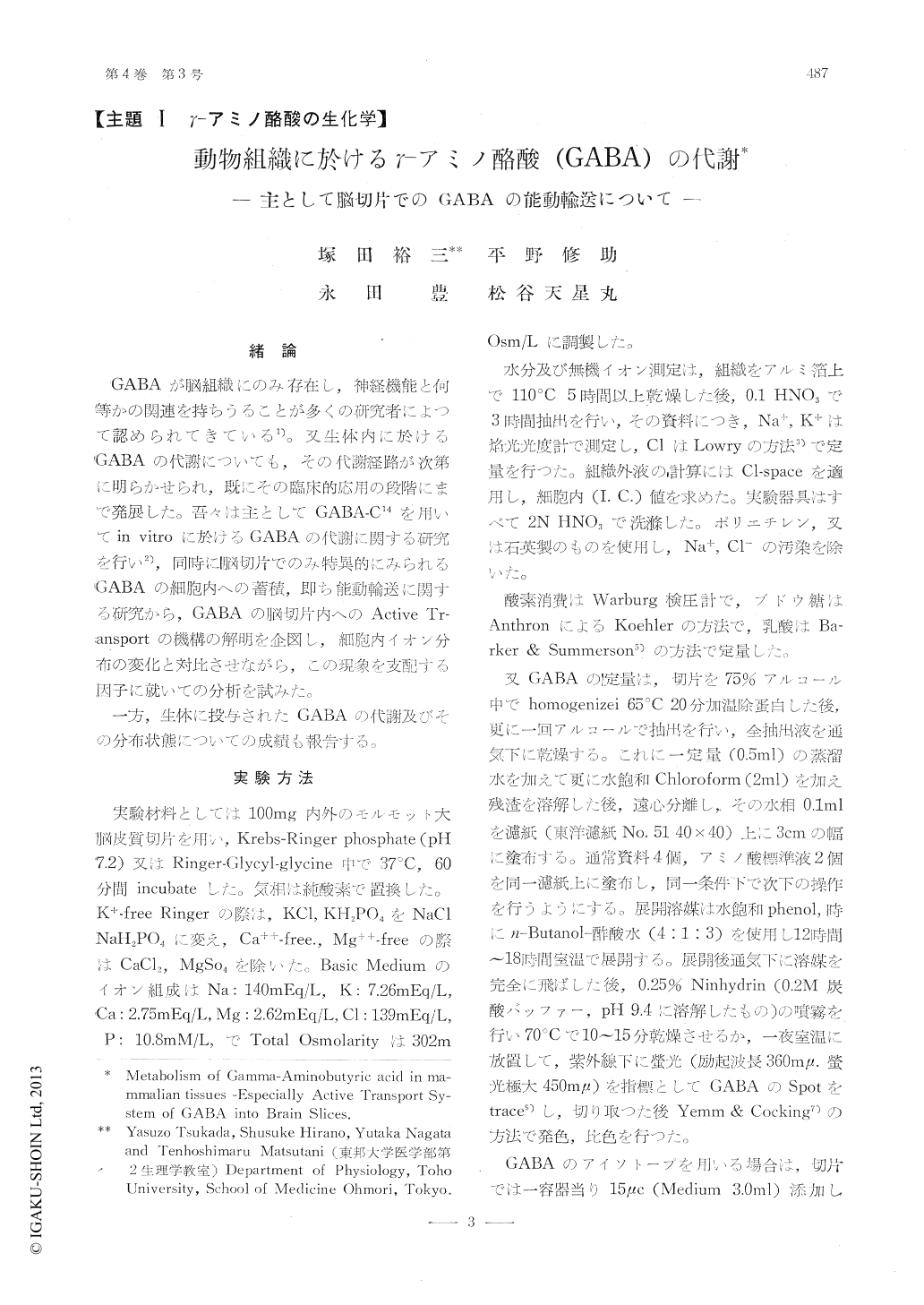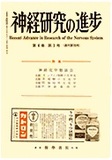Japanese
English
- 有料閲覧
- Abstract 文献概要
- 1ページ目 Look Inside
1)モルモット大脳皮質切片への,GABAの取込みをみると,能動的に組織内にaccumulateするのがみられるが,そのAccumulatlonRateはK+-free Mediumでは低く,Ca++-free me-diumでは高い。Pyridoxal添加でも,そのRatioは増加する。又継時的にそのAccumulationRateを追跡すると,2時間迄増加し,時後次第に低下する。30分迄はほぼ直線的に増加した。
2)Cl-spaceにより各種条件下での脳組職内のイオン分布及組織内水分量の変動を追究すると,GABA5mM添加時にはGABAは明らかに組織内に能動的に取込まれ,K+漏出,Na++の移入は少く,組総内水分量の増大もみられない。K+-freeでは組総内K+漏出と組織内へのNa+移入がみられるが,GABA添加で影響を受けない。Ca++-free MediumではK+漏出,Na++の移入がみられるがGABAを添加することにより此の現象は阻止される。
3)脳,肝,腎切片での代謝をみると,GABA添加時に脳,腎で酸素消費の増加がみられ,肝では影響がない。糖消費乳酸形成は,腎でのみGABA添加により抑制される。
4)GABA-C14を加えたMedium中で脳肝腎切片を好気的にincubateすろとC14O2を産生し脳,腎でほぼ等しく,共に肝に比し著しく高い。Radioautogramでは脳ではGABA,グルタミン酸,アスパラギン酸,グルタミンにC14-Spotを認めるが腎,肝ではGABA-C14のSpotが認められるのみである。又嫌気的条件では,GABA-C14の他に未知のC14-Spot(Ninhydrin反応陰性)を認める他C14-Spotは認められない。
5)家兎,モルモット,ラッテの静脈内にGABAを与えると,尿中排泄量は6時間で投与量の10%であるが,その血中量は極めて少い。又各臓器への分布は,腎でGABA-C14が稍多く認められるが他臓器では殆んど認められない。ただ肝及び血液中にGABA-C14以外の新しいSpotを認めた。
経口投与では,GABAは血中に殆んど認められないが,肝では静脈内投与時よりむしろ多くのGABAを認め尿中にもGABAの排泄が見られた。経口,静脈内投与共に脳内にはGABAの移入は認められなかつた。
1) When guinea pig brain cortex slices wereincubated in a medium containing GABA, GABAwas actively accumulated into brain slices duringthe periods of 2 hrs. in the presence of glucoseas a substrate. Accumation of GABA into braincortex slices was increased by omitting Ca ionsfrom a medium and diminished by omitting Kions.
As a special carrier system of active transportof GABA, turnover of phospholipids in cytoplasmic particulates of brain slices was investigated using P32 When GABA was accumulatedactively in brain slices, P32 incorporation intophospholipid fractions particularly phosphatidicacid and phosphatidylcholine of cytoplasmic particulates in brain slices was markedly accelerated. But in the condition such as K+-free medium withGABA or in the absence of GABA, an increase ofturnover rate of phospholipids was not observed.
2) Assuming chloride space, the changes ofintracellular water and electrolytes in brain sliceswere studied. When brain cortex slices was incubated in a medium containing 5mM GABA, thechanges of T. C. water, Na+ and K+ were veryslight although GABA itself was accumulated actively. In the case of conditions such as K+-free, Ca++-free and 10mM GABA in the medium, Nagain into intracellular phase and K loss were observed. And K leakage from the cells was inhibited by the addition of GABA to Ca. freemedium accompaning with the accumulation ofGABA. On Inulin assumption, I. C. water and I. C. Na were much higher than that of chloride. assumption, but I. C. K was shown at the sameorder on both assumption. At the same time I. C. chloride was detected almost same amount of I. C. Na. Then it would be likely that isotonicNaCl was penetrated into the cells from themedium under the slice condition. Accordingly, chloride assumption still will be satisfactory forthe calculation of I. C. space, since extra NaClshould be cancelled out automatically by the application of chloride assumption.
3) When GABA was added to the controlmedium containing glucose, oxygen consumptions.of brain and kidney cortex slices were augmentedbut not on liver slices. Total counts of C14O2.produced from GABA-C14 were almost the sameorder on the brain and kidney cortex slices respiring in the medium containing glucose. On.radioautogram, tagged spots in extracts of brainslices were detected corresponding to severalamino acids such as aspartic, glutamic acid, glutamine and GABA-C14. On the other hand, no, detectable tagged spots were obtained other thanGABA-C14 in extracts of kidney and liver slices.
4) The distribution of GABA in various organswas examined by the administration of GABA-C14to the animals. When GABA was administeredintravenously (1g/kg) or orally (1.5g/kg) to adultguinea pigs and mice, GABA-C14 was detectedclearly in kidney and liver. In blood GABA administered was only trace amount 3hrs. after intravenous administration. Unidentified taggedspot was found particularly in liver. GABA-C14was excreted in urine shortly after administration. By the intravenous injection of GABA, 10% ofGABA administered appeared for 6 hrs. after injection, and only 1% was detected by the oraladministration. No tagged GABA was found inbrain tissue by both oral and intravenous administration.

Copyright © 1960, Igaku-Shoin Ltd. All rights reserved.


